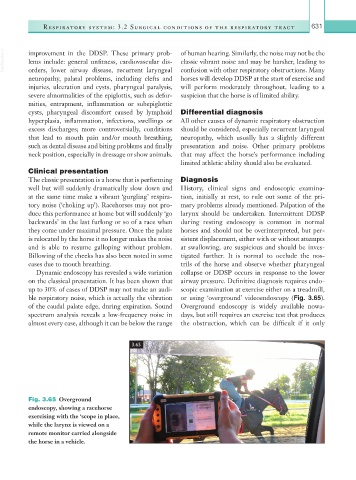Page 656 - Equine Clinical Medicine, Surgery and Reproduction, 2nd Edition
P. 656
Respir atory system: 3.2 Surgical conditions of the respir atory tr act 631
VetBooks.ir improvement in the DDSP. These primary prob- of human hearing. Similarly, the noise may not be the
classic vibrant noise and may be harsher, leading to
lems include: general unfitness, cardiovascular dis-
orders, lower airway disease, recurrent laryngeal
horses will develop DDSP at the start of exercise and
neuropathy, palatal problems, including clefts and confusion with other respiratory obstructions. Many
injuries, ulceration and cysts, pharyngeal paralysis, will perform moderately throughout, leading to a
severe abnormalities of the epiglottis, such as defor- suspicion that the horse is of limited ability.
mities, entrapment, inflammation or subepiglottic
cysts, pharyngeal discomfort caused by lymphoid Differential diagnosis
hyperplasia, inflammation, infections, swellings or All other causes of dynamic respiratory obstruction
excess discharges; more controversially, conditions should be considered, especially recurrent laryngeal
that lead to mouth pain and/or mouth breathing, neuropathy, which usually has a slightly different
such as dental disease and biting problems and finally presentation and noise. Other primary problems
neck position, especially in dressage or show animals. that may affect the horse’s performance including
limited athletic ability should also be evaluated.
Clinical presentation
The classic presentation is a horse that is performing Diagnosis
well but will suddenly dramatically slow down and History, clinical signs and endoscopic examina-
at the same time make a vibrant ‘gurgling’ respira- tion, initially at rest, to rule out some of the pri-
tory noise (‘choking up’). Racehorses may not pro- mary problems already mentioned. Palpation of the
duce this performance at home but will suddenly ‘go larynx should be undertaken. Intermittent DDSP
backwards’ in the last furlong or so of a race when during resting endoscopy is common in normal
they come under maximal pressure. Once the palate horses and should not be overinterpreted, but per-
is relocated by the horse it no longer makes the noise sistent displacement, either with or without attempts
and is able to resume galloping without problem. at swallowing, are suspicious and should be inves-
Billowing of the cheeks has also been noted in some tigated further. It is normal to occlude the nos-
cases due to mouth breathing. trils of the horse and observe whether pharyngeal
Dynamic endoscopy has revealed a wide variation collapse or DDSP occurs in response to the lower
on the classical presentation. It has been shown that airway pressure. Definitive diagnosis requires endo-
up to 30% of cases of DDSP may not make an audi- scopic examination at exercise either on a treadmill,
ble respiratory noise, which is actually the vibration or using ‘overground’ videoendoscopy (Fig. 3.65).
of the caudal palate edge, during expiration. Sound Overground endoscopy is widely available nowa-
spectrum analysis reveals a low-frequency noise in days, but still requires an exercise test that produces
almost every case, although it can be below the range the obstruction, which can be difficult if it only
3.65
Fig. 3.65 Overground
endoscopy, showing a racehorse
exercising with the ‘scope in place,
while the larynx is viewed on a
remote monitor carried alongside
the horse in a vehicle.

